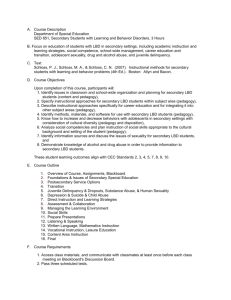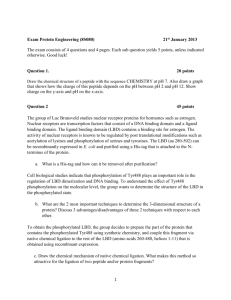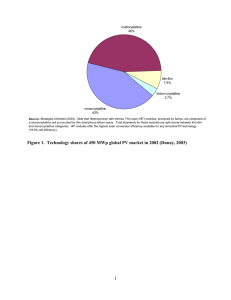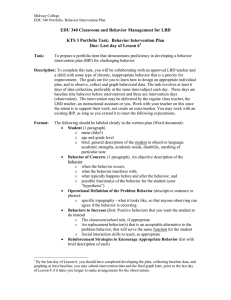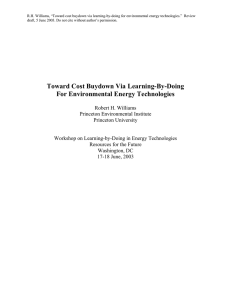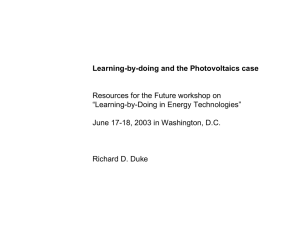Toward Cost Buydown Via Learning-By-Doing For Environmental Energy Technologies
advertisement
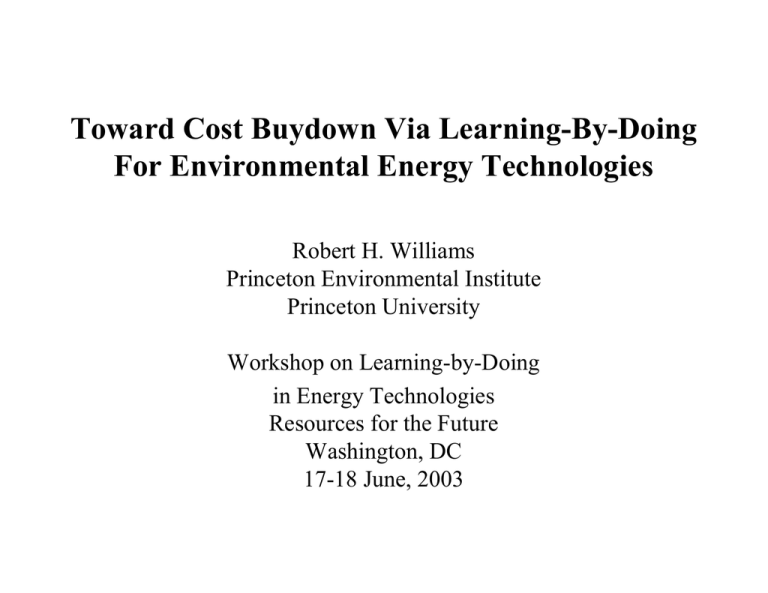
Toward Cost Buydown Via Learning-By-Doing For Environmental Energy Technologies Robert H. Williams Princeton Environmental Institute Princeton University Workshop on Learning-by-Doing in Energy Technologies Resources for the Future Washington, DC 17-18 June, 2003 LEARNING CURVES • Learning curves relate labor costs for given product by specific firm to cumulative production as quantification of observations that: – Manufacturing experience facilitates worker skill improvements. – Benefits tend to increase in regular manner with cumulative production—which serves as proxy for stock of worker skill improvements thereby achieved. • Quantification: For many products over long time periods, cost of producing a unit of product found to be related to its cumulative production by learning-by-doing (LBD) equation: y = ax-b, where: y = cost of producing next unit of product x = cumulative production a = constant coefficient b = learning rate exponent. • Learning rate exponent usually presented as progress ratio PR = (100*2-b) or learning rate LR = 100*(1 – 2-b). EXPERIENCE CURVES • During 1970s, Boston Consulting Group (BCG) introduced experience curves that generalize learning curve concept: – Empirical evidence that overall costs tend to increase with each doubling of cumulative production… as result of improvements from all conceivable opportunities for cost reduction, including technological improvement via fruits of R&D, input substitution, economies of scale, new product design, and changing input prices. – Typically, experience curves presented in terms of product prices, which are readily observable, instead of costs, which are not. • Dutton and Thomas (1984) compiled > 100 firm-level experience curve studies from variety of manufacturing sectors, finding mean LR ~ 20% (~ PR = 80%). • When innovations spill over among competing firms, industrywide experience curve can be estimated (weighted average of experience curves for individual firms). • Competitive industries that make major R&D investments tend to have high LRs, while more mature industries that invest little in R&D tend to have low LRs (Cody and Tiedje, 1992) . EXPERIENCE CURVES FOR ENERGY 20000 1983 RD&D pha s e 1981 Pho tov o ltaic s (learning rate ~ 20%) Comme rcia liza tion pha s e 10000 US (1990)$/kW 5000 2000 US A Japan 1992 1995 Wind m ills (US A) (learning rate ~ 20%) 1982 1000 1987 500 1963 Gas turb ines (USA) 1980 (le arning rate ~ 20%, ~10%) 200 100 10 100 1000 10000 100000 Cumula tive MW ins ta lle d MacDonald and Schrattenholzer (2001) catalogue experience curves for wide range of energy technologies and find LRs in range 5-25%: – Higher LRs for more modular systems amenable to mass production in factories; – Lower LRs for large field-erected plants for which standardized designs are more difficult to realize. SPECIFIC INVESTMENT COST (1998 FF/kWe) FOR NUCLEAR POWER IN FRANCE VS CUMULATIVE INSTALLED CAPACITY (GWe) 11000 65.7 GW, 2000 10000 9000 25.5 GW, 1983 1.8 GW, 1977 43.7 GW, 1986 8000 7000 1 10 100 Specific investment costs for nuclear power rose with experience in France [to $1920/kWe (2002 US$) in 2000], despite the favorable investment climate for nuclear technology and French success in standardizing nuclear power plant designs. Installed nuclear capacity (GW) Source: Calculations (preliminary) carried out by Arnulf Grübler (IIASA), based on data presented in P. Girard (Commissariat à l’Energie Atomique), Y. Marignac (WISEParis), and J. Tassart (La Commission Française du Développment Durable), Le Parc Nucléaire Actuel, Mission d’évaluation économique de la filière nucléaire, March 2000. THEORY OF EXPERIENCE CURVE NEEDED • Simplicity of experience curve model with cumulative production as the main explanatory variable for estimating cost reductions is appealing…but model lacks sound theoretical basis. • Duke (2002) suggests why R&D & scale economy impacts might roughly be captured by cumulative production index: – Key part of new technology deployment process is firm’s R&D, for which cost ∝ sales revenues…and government support for industrial R&D tends to be cost-shared Î plausibly, cumulative total R&D investments ∝ cumulative production. – There are limits on firm’s ability to reduce costs through dramatic scale-up without first working out the kinks in intermediate-scale manufacturing facilities Î LBD is integral part of process of ramping up production. UNCERTAINTIES IN USING EXPERIENCE CURVES TO PREDICT PRICES—PV EXAMPLE 100 All-PV Retail Price 1976-2000 Learning Rate = 20% 2003: 2.3 GWp, $3.90/Wp $70 billion buydown 2000$/W p 10 Thin-film only Learning rate = 20% 0.23 GWp & $3.90/Wp in 2003 $7 billion buydown 1 0.1 00.1 1 10 100 1,000 10,000 100,000 1,000,000 cumulative MWp Cost of “buying down” PV cost to $1/Wp: – $70 billion if historical LR (19.7%) persists – $225 ($30) billion if LR changes to 15% (25%) – $7 billion if thin-film PV experience curve with same LR (19.7%) takes over SOME IMPORTANT USES OF EXPERIENCE CURVES IN ENERGY TECHNOLOGY POLICY ANALYSIS • Explore (e.g., via IAMs) implications for costs of mitigating climate change and other insults of LBD for advanced energy technologies. • Explore effort required to reach cost goals for advanced technologies by combining experience curve analysis with detailed technology assessment (TA) of manufacturing costs under mass-production conditions. • Assist policymakers in selecting technologies for public sector buydown support and subsequently in deciding whether to sustain or curtail such support. APPLICATION OF LBD TO CCS FOR MAKING ELECTRICITY, H2 & C-BASED SYNFUELS • Rubin et al. (2003) measured LRs = 11% and 12% for capital costs for FGD (SO2) and SCR (NOx) stack-gas clean-up technologies…and found that most of the cost reduction was accounted for by technological innovation • As follow-up, Riahi et al. (2003) used IIASA MESSAGE-MACRO IAM to explore impacts of LBD for CO2 capture & storage (CCS) in reducing global CO2 emissions for variant of IPCC’s A2 global energy scenario (from SRES) that incorporates CCS technologies to help reduce atmospheric CO2 in 2100 from 783 ppmv to 550 ppmv, assuming, alternatively, LR = 12% and 0% for CCS technologies • This IAM exercise found that: – With LBD, the required carbon tax would be reduced: • In 2020 to $19/tC—from $25/tC without LBD • In 2050 to $27/tC—from $82/tC without LBD – By 2100, twice as much CO2 would be sequestered with LBD than without LBD WHY PUBLIC-SECTOR COST BUYDOWN SUPPORT FOR ENVIRONMENTAL ENERGY TECHNOLOGIES • Radical technological change needed to cope with 21st century energy challenges [climate change, air pollution (esp. small particle health impacts), energy supply insecurity] while keeping energy affordable. • Need for government support for energy R&D widely appreciated. • Conventional wisdom: private sector should have sole responsibility for commercialization (technology cost buydown). • In part, government support for environmental energy technology commercialization justified because costs of environmental/energy supply insecurity damages not fully internalized in energy prices. • More fundamentally, government support warranted because of positive externality: private firm underinvests in technology cost buydown via LBD because of risk that fruits of buydown investment will spill over to competitors (Duke and Kammen, 1999; Duke, 2002). CRITERIA FOR MAXIMIZING NPV OF PUBLIC-SECTOR BUYDOWN SUPPORT FOR NEW ENERGY TECHNOLOGIES (Duke, 2002) • High LBD spillover; • Emerging data suggest steep experience curve; • Technology assessments project low price floor; • Niche markets insufficient to pull prices down rapidly, but at lower prices demand is price elastic s.t. buydown subsidies can open up large markets; • No other technology (incumbent or emerging) has better long-term prospects in the relevant market segments; • Targeted technology produces strong public benefits not related to private under-investment in LBD—e.g., major environmental benefits. TOWARD A POLICY FOR FOR PUBLIC-SECTOR SUPPORT OF TECHNOLOGY COST BUYDOWN • Support portfolio of technologies that satisfy selection criteria—thus reducing overall program performance risk through diversification. • Minimize potential for evolving pork barrel projects (e.g., grain ethanol subsidies)—is an independent Energy Commercialization Policy Agency needed [as proposed by Duke (2002)]? • Develop efficient policy instruments for buydown support: – Those that maximize use of market forces for resource allocation among qualifying technologies desirable. – Explore prospects for adapting successful existing policy instruments to buydown task—e.g., might the Renewable Portfolio Standard be adapted to this task? ILLUSTRATIVE POLICY OPTIONS • Establish Energy Commercialization Policy Agency (Duke, 2002) independent of any agency promoting technologies that might become candidates for buydown support. ECPA would assist policymakers by: – Providing TA advice regarding candidate technologies for buydown support; – Monitoring/evaluating field performance of subsidized technologies; – providing advice on periodic reallocation of subsidy resources in light of monitoring/evaluations; – Subjecting its activities to external review by academics and disinterested managers with generic expertise in technology commercialization. • Convert Renewable Portfolio Standard into buydown instrument: – RPS uses market forces to allocate subsidy resources among qualifying technologies; – Texas RPS deals with concern about uncertain future costs for renewables by putting price cap on Renewable Energy Credit; – By specifying quantity of supply to be subsidized over time, renewable-energy developers are given confidence to launch projects; – RPS could be adapted to buydown by redesign to support portfolio of qualifying technologies…including qualifying non-renewable energy technologies; – ECPA activities would help control costs. CURRENT/PROJECTED COAL IGCC PERFORMANCE/COST [FOSTER-WHEELER (2003) FOR IEA GHG R&D PROGRAMME] Current, CO2: vented cap/stor 2020 (projected), CO2: vented cap/stor Capacity (MWe) 827 730 879 776 Efficiency (%, LHV) 38.0 31.5 48.9 43.2 Specific investment cost ($/kWe) 1187 1495 1129 1248 4.14 4.14 3.72 3.72 CO2 capture (85% capture) - 1.00 - 0.41 CO2 transport/storage (@ $5/t CO2) - 0.43 - 0.31 4.14 5.57 3.72 4.45 1.43 - 0.73 79 - 51 Generation cost (¢/kWh) With venting Total generation cost Incremental cap/stor cost (¢/kWh) Cost of emissions avoided ($/t C) - THOUGHT EXPERIMENT: PORTFOLIO STANDARD TO ADVANCE CO2 CAPTURE/STORAGE FOR US COAL POWER w/LBD & w/o LBD • Require 20% of US coal power decarbonized (85% level) by 2020 • Assume: •Coal power generation constant at 2005 level (1990 TWh/y) •Linear ramp up of decarbonized IGCC power, 2005-2020 •Cost for capture/storage paid by CO2 emissions fee on coal power plants •For LBD case assume FW IGCC cost projections are realized by 2020 Î LR for CO2 capture/storage = 14.9% w/LBD w/o LBD Cumulative Subsidy ($109) 35.1 42.3 “Effective” ave CT ($/tC) 4.8 5.8 Incremental coal steam power cost in 2020 (¢/kWh) 0.24 0.34 Impacts: • CO2 emissions for coal power (2020) = 0.83X 2005 rate • CO2 storage rate for coal power (2020) = 300 million t CO2 per year TOWARD AN INTEGRATED AND EFFECTIVE ENERGY TECHNOLOGICAL INNOVATION POLICY • Radical technological change for energy technology is required to address effectively the major environmental and energy supply insecurity posed by conventional energy. • Both reinvigoration of energy R&D enterprise and technology cost buydown support are needed. • These activities would be mutually reinforcing: – Increased R&D would help sustain high LRs; – Market growth from buydown success would catalyze increased R&D investments by firms involved. • Experience has highlighted promising policy instruments that might be adapted to buydown, although experimentation with alternative approaches is desirable to find out what works best with different classes of technologies and perhaps in different regions as well. References Cody, G. D. and T. Tiedje, 1992: The potential for utility scale photovoltaic technology in the developed world: 1990-2010, Energy and the Environment, B. Abeles, A. J. Jacobson and P. Sheng. Singapore, World Scientific. Duke, R., 2002: Clean Energy Technology Buydowns: Economic Theory, Analytic Tools, and the Photovoltaics Case, PhD. dissertation, Princeton University, November. Duke, R., and D. Kammen, 1999: The Economics of energy market transformation initiatives, The Energy Journal, 4: 15-64. Dutton, J. M. and A. Thomas, 1984: Treating progress functions as a managerial opportunity, Academy of Management Review, 9(2): 235-247. Foster Wheeler Energy Ltd., 2003: Potential for Improvement in Gasification Combined Cycle Power Generation with CO2 Capture, IEA Greenhouse Gas R&D Programme, UK. McDonald, A. and L. Schrattenholzer, 2001: Learning rates for energy technologies, Energy Policy, 29: 255-261. Riahi, K., E. Rubin, M. Taylor, L. Schrattenholzer, and D. Hounshell, Technological learning for carbon capture and sequestration technologies, Energy Economics (in press). Rubin, E., M.Taylor, S. Yeh, and S.Hounshell, Learning curves for environmental technologies and their importance for climate policy analysis, Energy, the International Journal (in press).



